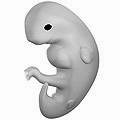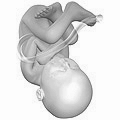
Pregnancy
Pregnancy is the time during which one or more offspring develops (gestates) inside a woman's uterus (womb).[4][13] A multiple pregnancy involves more than one offspring, such as with twins.[14]
This article is about pregnancy in humans. For other mammals, see Pregnancy (mammals). For fish, see Pregnancy in fish.Pregnancy
Gestation
Missed periods, tender breasts, nausea and vomiting, hunger, frequent urination[1]
~40 weeks from the last menstrual period (38 weeks after conception)[4][5]
Birth control (including emergency contraception)[8]
213 million (2012)[11]
![]() 230,600 (2016)[12]
230,600 (2016)[12]
Pregnancy usually occurs by sexual intercourse, but can also occur through assisted reproductive technology procedures.[6] A pregnancy may end in a live birth, a miscarriage, an induced abortion, or a stillbirth. Childbirth typically occurs around 40 weeks from the start of the last menstrual period (LMP), a span known as the gestational age.[4][5] This is just over nine months. Counting by fertilization age, the length is about 38 weeks.[5][13] Pregnancy is "the presence of an implanted human embryo or fetus in the uterus"; implantation occurs on average 8–9 days after fertilization.[15] An embryo is the term for the developing offspring during the first seven weeks following implantation (i.e. ten weeks' gestational age), after which the term fetus is used until birth.[5]
Signs and symptoms of early pregnancy may include missed periods, tender breasts, morning sickness (nausea and vomiting), hunger, implantation bleeding, and frequent urination.[1] Pregnancy may be confirmed with a pregnancy test.[7] Methods of birth control—or, more accurately, contraception—are used to avoid pregnancy.
Pregnancy is divided into three trimesters of approximately three months each. The first trimester includes conception, which is when the sperm fertilizes the egg. The fertilized egg then travels down the fallopian tube and attaches to the inside of the uterus, where it begins to form the embryo and placenta. During the first trimester, the possibility of miscarriage (natural death of embryo or fetus) is at its highest. Around the middle of the second trimester, movement of the fetus may be felt. At 28 weeks, more than 90% of babies can survive outside of the uterus if provided with high-quality medical care, though babies born at this time will likely experience serious health complications such as heart and respiratory problems and long-term intellectual and developmental disabilities.
Prenatal care improves pregnancy outcomes.[9] Nutrition during pregnancy is important to ensure healthy growth of the fetus.[16] Prenatal care may also include avoiding recreational drugs (including tobacco and alcohol), taking regular exercise, having blood tests, and regular physical examinations.[9] Complications of pregnancy may include disorders of high blood pressure, gestational diabetes, iron-deficiency anemia, and severe nausea and vomiting.[3] In the ideal childbirth, labor begins on its own "at term".[17] Babies born before 37 weeks are "preterm" and at higher risk of health problems such as cerebral palsy.[4] Babies born between weeks 37 and 39 are considered "early term" while those born between weeks 39 and 41 are considered "full term".[4] Babies born between weeks 41 and 42 weeks are considered "late-term" while after 42 weeks they are considered "post-term".[4] Delivery before 39 weeks by labor induction or caesarean section is not recommended unless required for other medical reasons.[18]
Demographics and statistics
About 213 million pregnancies occurred in 2012, of which, 190 million (89%) were in the developing world and 23 million (11%) were in the developed world.[11] The number of pregnancies in women aged between 15 and 44 is 133 per 1,000 women.[11] About 10% to 15% of recognized pregnancies end in miscarriage.[2] In 2016, complications of pregnancy resulted in 230,600 maternal deaths, down from 377,000 deaths in 1990.[12] Common causes include bleeding, infections, hypertensive diseases of pregnancy, obstructed labor, miscarriage, abortion, or ectopic pregnancy.[12] Globally, 44% of pregnancies are unplanned.[27] Over half (56%) of unplanned pregnancies are aborted.[27] Among unintended pregnancies in the United States, 60% of the women used birth control to some extent during the month pregnancy began.[28]
The usual signs and symptoms of pregnancy do not significantly interfere with activities of daily living or pose a health-threat to the mother or baby. However, pregnancy complications can cause other more severe symptoms, such as those associated with anemia.
Common signs and symptoms of pregnancy include:
A pregnant woman may have a pre-existing disease, which is not directly caused by the pregnancy, but may cause complications to develop that include a potential risk to the pregnancy; or a disease may develop during pregnancy.



